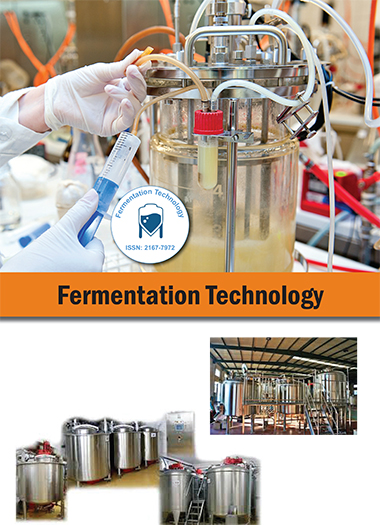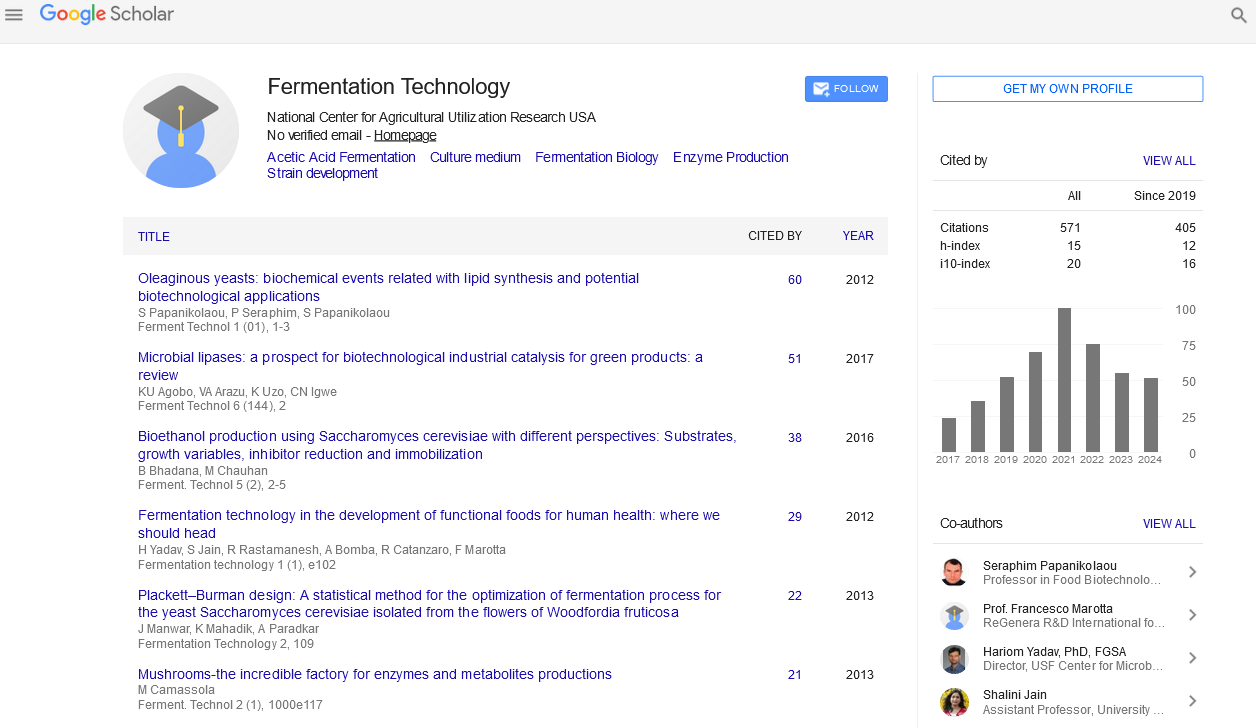Indexed In
- Open J Gate
- Genamics JournalSeek
- Access to Global Online Research in Agriculture (AGORA)
- RefSeek
- Hamdard University
- EBSCO A-Z
- OCLC- WorldCat
- Publons
Useful Links
Share This Page
Journal Flyer

Open Access Journals
- Agri and Aquaculture
- Biochemistry
- Bioinformatics & Systems Biology
- Business & Management
- Chemistry
- Clinical Sciences
- Engineering
- Food & Nutrition
- General Science
- Genetics & Molecular Biology
- Immunology & Microbiology
- Medical Sciences
- Neuroscience & Psychology
- Nursing & Health Care
- Pharmaceutical Sciences
Short Communication - (2023) Volume 12, Issue 1
Fermentation Efficiency and Quality in Wheat Products
Daiyu Zhang*Received: 03-Mar-2023, Manuscript No. FMT-23-20921; Editor assigned: 06-Mar-2023, Pre QC No. FMT-23-20921(PQ); Reviewed: 21-Mar-2023, QC No. FMT-23-20921; Revised: 28-Mar-2023, Manuscript No. FMT-23-20921(R); Published: 07-Apr-2023, DOI: 10.4172/2167-7972.23.12.164
Description
Finding new processing techniques is a crucial area for research in the field of food engineering. Products made from fermented flour have a long history of global popularity due to their distinctive flavor and texture. The fermentation process depends on precise temperature management, whether it's for yeast or sourdough. The processing of items made from fermented flour has showed promise for several cutting-edge heating techniques [1-4]. The most promising heating techniques are without a doubt Microwave Heating (MWH), Radiofrequency Heating (RFH) and Ohmic Heating (OH). MWH may also enhance the fermentation quality of items made with whole-wheat flour.
MWH alters the water molecules in the dough, which affects the dough's fermentation time. RFH has the potential to be used in the production of sourdough bread and helps to keep dangerous elements under control throughout the fermentation process. Shortening the fermentation time is a benefit of OH's improved ability to precisely manage the temperature, enzymes, microbes, etc. during the fermentation process. These heating techniques have been used by researchers for a variety of purposes. The use and promise of these three unique heating techniques in the creation of fermented flour products were outlined in this article [5-8]. More study is required on the application scenarios and parameter configurations of novel heating technologies in the fermentation process of dough. It is conceivable that cutting-edge heating techniques will someday play a significant role in enhancing dough fermentation effectiveness and dough quality. One of the most popular processes for making flour products is fermentation, which is also a crucial phase in defining the final texture and quality of flour products. Both Western baked bread and Eastern steamed bread are prepared from dough that contains 50% to 60% water after going through various fermentation processes, such as sourdough fermentation and pure yeast fermentation. The principle of fermentation is that the yeast breathes using sugars like glucose and fructose while releasing carbon dioxide to create gas cells in the dough. Due to the diversity of bacteria, sourdough accelerates the process of decomposition of several macromolecular compounds (protein, starch, etc.) in the dough when compared to dry yeast. In addition, differing from yeast, sourdough can be classified according to the fermentation process and technological method. Yeast and Lactic Acid Bacteria (LAB), which grow spontaneously in the right circumstances, are components of type I sourdough. Type I and type II sourdoughs are combined to create type IV sourdough, which is typically converted into liquid during cultivation. Type II sourdough is created by inoculating the dough with various concentrations of bacteria [9]. Type III sourdough is created simply by dehydrating type II sourdough. Nevertheless introducing dangerous bacteria and microbial toxins during fermentation is made more likely by high moisture content and extended fermentation times. In order to reduce the amount of dangerous compounds while maintaining the quality of the fermentation, it is necessary to minimize the fermentation time as much as feasible. Customers demand exceptional quality and an extended shelf life from fermented goods. As many quality changes occurring during the distribution and storage of these foods are caused by harmful microorganisms and enzymecatalyzed reactions involving Escherichia coli, Staphylococcus aureus, peroxidase, polyphenol oxidase, pectin methyl esterase, etc., traditional heating treatments have been used to reduce the quantity of microbes in fermented foods and deactivate enzymes.
Thermal processing, however, also modifies the nutritional value and textural characteristics of the dough and products [10]. Traditional heating techniques may cause some unfavorable modifications related to the conversion of thermo labile chemicals into other products throughout the fermentation process. In order to reduce product quality loss, contemporary fermentation methods typically use constant temperature control systems. Novel physical technologies have the potential to completely or partially replace conventional heating processes and they have drawn increasing attention from researchers in terms of industrial applications as a result of technological advancements and higher expectations for high-quality fermented products.
References
- Cheirsilp B, Radchabut S. Use of whey lactose from dairy industry for economical kefiran production by Lactobacillus kefiranofaciens in mixed cultures with yeasts. N Biotechnol. 2011;28(6):574-580.
[Crossref] [Google Scholar] [PubMed]
- Church FC, Porter DH, Catignani GL, Swaisgood HE. An o-phthalaldehyde spectrophotometric assay for proteinases. Anal Biochem. 1985;146(2):343-348.
[Crossref] [Google Scholar] [PubMed]
- Coda R, Rizzello CG, Pinto D, Gobbetti M. Selected lactic acid bacteria synthesize antioxidant peptides during sourdough fermentation of cereal flours. Appl Environ Microbiol. 2012;78(4):1087-1096.
[Crossref] [Google Scholar] [PubMed]
- Dubois M, Gilles K, Hamilton JK, Rebers PA, Smith F. Colorimetric determination of reducing and nonreducing saccharides. Nature. 1951;168:167-169.
[Crossref] [Google Scholar] [PubMed]
- Jung UJ, Lee MK, Park YB, Jeon SM, Choi MS. Antihyperglycemic and antioxidant properties of caffeic acid in db/db mice. J Pharmacol Exp Ther. 2006;318(2):476-483.
[Crossref] [Google Scholar] [PubMed]
- Mateo Anson N, Aura AM, Selinheimo E, Mattila I, Poutanen K, Van Den Berg R, et.al. Bioprocessing of wheat bran in whole wheat bread increases the bioavailability of phenolic acids in men and exerts antiinflammatory effects ex vivo. J Nutr. 2011;141(1):137-143.
[Crossref] [Google Scholar] [PubMed]
- Onipe OO, Jideani AI, Beswa D. Composition and functionality of wheat bran and its application in some cereal food products. Int. J. Food Sci.. 2015;50(12):2509-2518.
- Pham PL, Dupont I, Roy D, Lapointe G, Cerning J. Production of exopolysaccharide by Lactobacillus rhamnosus R and analysis of its enzymatic degradation during prolonged fermentation. Appl Environ Microbiol. 2000;66(6):2302-2310.
[Crossref] [Google Scholar] [PubMed]
- Russo, P, de Chiara, M. L. V, Capozzi, V, Arena, M. P, et al. Lactobacillus plantarum strains for multifunctional oat-based foods. LWT - Food Sci. Technol. 2016; 68:288–294.
- Singleton VL, Orthofer R, Lamuela-Raventós RM. Analysis of total phenols and other oxidation substrates and antioxidants by means of folin-ciocalteu reagent. Meth. Enzymol 1999;299:152-178.
Citation: Zhang D (2023) Fermentation Efficiency and Quality in Wheat Products. Ferment Technol. 12:164.
Copyright: © 2023 Zhang D. This is an open-access article distributed under the terms of the Creative Commons Attribution License, which permits unrestricted use, distribution, and reproduction in any medium, provided the original author and source are credited.

